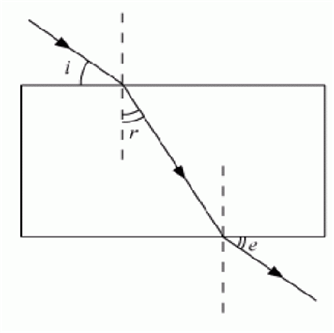 Multiple Choice Questions
Multiple Choice QuestionsA student traces the path of a ray of white light through a rectangular glass slab and marks, the angles of incidence (∠i) , refraction (∠r) and emergence (∠e) as shown. Which angle or angles has he not marked correctly?
∠i only
∠i and ∠r
∠i and ∠e
∠i and ∠e
While tracing the path of a ray of light passing through a rectangular glass slab a student tabulated his observations as given below:
|
S.NO. |
∠i |
∠r |
∠e |
|
I |
60° |
40° |
61° |
|
II |
50o |
36o |
51o |
|
III |
40o |
28o |
39o |
|
III |
40o |
28o |
39o |
D.
|
III |
40o |
28o |
39o |
The correct option is D.
As per Snell’s law
The ratio of the sine values of i and r should be 1.5.
Note: Refractive index of glass = 1.5 and refractive index of air is 1.
To determine focal length of a concave mirror a student obtains the image of a well-lit distant object on a screen. To determine the focal length of the given concave mirror he needs to measure the distance between:
mirror and the object
mirror and the screen
screen and the object
screen and the object
A student obtained a sharp image of the grills of a window on a screen using a concave mirror. His teacher remarked that for getting better results a well-lit distant object (preferably the sun) should be focused on the screen. What should be done for this purpose?
Move the screen slightly away from the mirror
Move the mirror slightly towards the screen
Move the screen and the mirror away from the object
Move the screen and the mirror away from the object
To determine the focal length of a convex lens by obtaining a sharp image of a distant object we generally follow the following steps which are not in proper sequence.
(a) Hold the lens between the object and the screen
(b) Measure the distance between the lens and the screen
(c) Select a well-lit distant object
(d) Place a screen opposite to the object on the lab table
(e) Adjust the position of the lens to form a sharp image
The correct sequence of these steps is:
c, a, d, e, b
c, d, a, e, b
c, d, e, a, b
c, d, e, a, b
Dry raisins were soaked in water for 2 hours, to determine the percentage of water absorbed by raisins. Before final weighing of swollen raisins, the extra water left on the surface of soaked raisins was removed by:
gently rubbing with cotton cloth
hot air blower
dry cotton wool
dry cotton wool
While performing the experiment with raisins to determine the percentage of water absorbed by them, a student made following measurements:
Mass of water in the beaker = 40 g
Mass of raisins before soaking = 5 g
Mass of raisins after soaking for 2 hours = 8 g
Mass of water left in the beaker after the experiment = 35 g
The percentage of water absorbed by raisins is:



After observing the prepared slides of binary fission in amoeba and budding in yeast following observations were reported:
(a) Single cells of amoeba and yeast were undergoing binary fission and budding respectively.
(B) Cytokinesis was observed in the yeast cell.
(C) Elongated nucleus was dividing to form two daughter nuclei in amoeba.
(D) A chain of buds were observed due to reproduction in amoeba.
The correct observation(s) is/are:
a and c
b only
c and d
c and d
A student after viewing a prepared slide illustrates the budding in yeast in the following order which is not correct:
b, c, d, e, a
b, e, d, c, a
b, d, e, c, a
b, d, e, c, a
A student has to observe a permanent slide of binary fission in amoeba. Find the correct sequence of steps given below for focusing the object under a microscope.
(a) Place the slide on the stage, look through the eye-piece and adjust the mirror to get proper illumination.
(b) Focus the slide sharp using fine adjustment screw
(c) Look through the eye-piece and raise the objective lens using coarse adjustment screw till the object is focused.
(d) Look through the eye-piece and move the slide till the object is visible.
d, c, b, a
a, b, d, c
a, d, c, b
a, d, c, b
